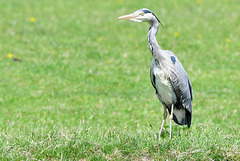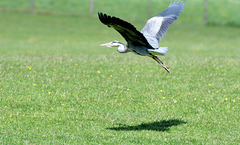
Snapshots
Born to be wild?
| |
|
|
|
I wonder if this man's name is Heath Robinson? UK viewers will "get" the joke but for those who are not familiar with the name and reference, please see below.
William Heath Robinson (1872 – 1944) was an English cartoonist, illustrator and artist, best known for drawings of whimsically elaborate machines to achieve simple objectives. In the UK the term "Heath Robinson" entered the popular language during the 1914–1918 World War as a description of any unnecessarily complex and implausible contrivance, much as "Rube Goldberg machines" came to be used in the United States from the 1920s onwards as a term for similar efforts. "Heath Robinson contraption" is perhaps more often used in relation to temporary fixes using ingenuity and whatever is to hand, often string and tape or unlikely cannibalisations. Its continuing popularity was undoubtedly linked to Britain's shortages and the need to "make do and mend" during the Second World War.
(Wikipedia).
Camera: Nikon D500
Lens: AF-S Nikkor 70-200mm f/2.8G ED VR II
Software: Nikon Capture NX2
Title "borrowed" from here:
www.youtube.com/watch?v=egMWlD3fLJ8
Black-headed gull (Larus ridibundus).
| |
|
|
|
This gull is 38–44 cm (15–17 in) long with a 94–105 cm (37–41 in) wingspan. The summer adult has a chocolate-brown head (not black, although does look black from a distance), pale grey body, black tips to the primary wing feathers and a red bill and legs. The hood is lost in winter leaving just 2 dark spots. Immature birds have a mottled pattern of brown spots over most of the body. It breeds in colonies in large reed beds or marshes, or on islands in lakes, nesting on the ground. Like most gulls it is highly gregarious in winter both when feeding or in evening roosts. The black-headed gull is a bold and opportunistic feeder. It eats insects, fish, seeds, worms, scraps and carrion in towns or invertebrates in ploughed fields with equal relish. It is a noisy species, especially in colonies, with a familiar "kree-ar" call. Its scientific name means laughing gull. It can be found over much of Europe except Spain, Italy and Greece. It is also found in Japan and Eastern China. It is an occasional visitor to the east coast of North America.
(Wikipedia).
Camera: Nikon D500
Lens: AF-S Nikkor 70-200mm f/2.8G ED VR II
Software: Nikon Capture NX2
Grey heron (Ardea cinerea).
| |
|
|
|
The grey heron (Ardea cinerea) is a long-legged predatory wading bird of the heron family, Ardeidae, native throughout temperate Europe and Asia and parts of Africa. It is resident in much of its range but some populations from the more Northern parts migrate southwards in autumn. A bird of wetland areas, it can be seen around lakes, rivers, ponds, marshes and on the sea coast. It feeds mostly on aquatic creatures which it catches after standing stationary beside or in the water or stalking its prey through the shallows. Standing up to 1 m tall, adults weigh from 1 to 2 kg (2.2 to 4.4 lb). They have a white head and neck with a broad black stripe that extends from the eye to the black crest. The body and wings are grey above and the underparts are greyish-white, with some black on the flanks. The long, sharply pointed beak is pinkish-yellow and the legs are brown.
(Wikipedia).
Camera: Nikon D500
Lens: AF-S Nikkor 70-200mm f/2.8G ED VR II
Software: Nikon Capture NX2
Grey heron (2 of 3).
| |
|
|
|
The grey heron (Ardea cinerea) is a long-legged predatory wading bird of the heron family, Ardeidae, native throughout temperate Europe and Asia and parts of Africa. It is resident in much of its range but some populations from the more Northern parts migrate southwards in autumn. A bird of wetland areas, it can be seen around lakes, rivers, ponds, marshes and on the sea coast. It feeds mostly on aquatic creatures which it catches after standing stationary beside or in the water or stalking its prey through the shallows. Standing up to 1 m tall, adults weigh from 1 to 2 kg (2.2 to 4.4 lb). They have a white head and neck with a broad black stripe that extends from the eye to the black crest. The body and wings are grey above and the underparts are greyish-white, with some black on the flanks. The long, sharply pointed beak is pinkish-yellow and the legs are brown.
(Wikipedia).
Camera: Nikon D500
Lens: AF-S Nikkor 70-200mm f/2.8G ED VR II
Software: Nikon Capture NX2
Grey heron (3 of 3).
| |
|
|
|
The grey heron (Ardea cinerea) is a long-legged predatory wading bird of the heron family, Ardeidae, native throughout temperate Europe and Asia and parts of Africa. It is resident in much of its range but some populations from the more Northern parts migrate southwards in autumn. A bird of wetland areas, it can be seen around lakes, rivers, ponds, marshes and on the sea coast. It feeds mostly on aquatic creatures which it catches after standing stationary beside or in the water or stalking its prey through the shallows. Standing up to 1 m tall, adults weigh from 1 to 2 kg (2.2 to 4.4 lb). They have a white head and neck with a broad black stripe that extends from the eye to the black crest. The body and wings are grey above and the underparts are greyish-white, with some black on the flanks. The long, sharply pointed beak is pinkish-yellow and the legs are brown.
(Wikipedia).
Camera: Nikon D500
Lens: AF-S Nikkor 70-200mm f/2.8G ED VR II
Software: Nikon Capture NX2
Shades of green.
| |
|
|
|
Photographed along the Reedley Hallows Greenway trail near the town of Reedley in Lancashire, North-West England.
Camera: Nikon D500
Lens: AF-S Nikkor 70-200mm f/2.8G ED VR II
Software: Nikon Capture NX2
Male Blackbird (Turdus merula).
| |
|
|
|
A familiar thrush, the melodious blackbird is a common sight in gardens, parks and woodlands across the UK. Blackbirds are especially fond of feeding on lawns and can be seen with their heads cocked to one side, listening for earthworms. Male blackbirds are unmistakable - they are entirely black, with a yellow bill and yellow ring around the eye. Females are dark brown, with streaking on the chest and throat. Juveniles are also dark brown, but covered with gingery streaks.
(The Wildlife Trusts).
Camera: Nikon D500
Lens: AF-S VR Zoom-Nikkor 70-300mm f/4.5-5.6G IF-ED
Software: Nikon Capture NX2
Eco Drive.
| |
|
|
|
A close-up test using a non-macro lens....it took many attempts before I managed to get a good shot without too many reflections. I don't know if this will really "run forever" (as claimed by Argos) but it will probably outlive me.....it has already outlived three watch-straps :-)
"A simple yet revolutionary concept: a watch that never needs a battery. Citizen Eco-Drive technology harnesses the power of light from any natural or artificial light source and converts it into energy which is stored in a permanently rechargeable lithium-ion cell. It recharges continuously in any kind of light to run forever."
(Argos advertisement).
www.argos.co.uk/product/9157332
Camera: Nikon D500
Lens: AF-S DX Zoom-Nikkor 17-55mm f/2.8G IF-ED
Software: Nikon Capture NX2
Signs & fences HFF.
| |
|
|
|
The pedestrian footpath which crosses the railway track near the town of Nelson in Pendle district, North-West England. HFF everybody :-)
Camera: Sony RX100.
Software: Nikon Capture NX2.
Woodland trail.
| |
|
|
|
Photographed in "Hard Platts" woods (which is about 500 metres from my home) on a rainy day. The rain usually helps to "saturate" colours in photographs and to bring out the different shades when a single colour dominates the image. There's also a very small HFF "contender" in the centre which can be better seen when "viewed on black".
Camera: Sony RX100
Software: Nikon Capture NX2
HFF with Buttercups (Ranunculaceae).
| |
|
|
|
Have a happy (and colourful) "Fence Friday" everyone :-)
Camera: Nikon D500
Lens: AF-S DX Zoom-Nikkor 17-55mm f/2.8G IF-ED
Software: Nikon Capture NX2
Seagull in flight.
| |
|
|
|
The European herring gull (Larus argentatus) is a large gull up to 26 inches (66 cm) long. One of the best known of all gulls along the shores of Western Europe, it was once abundant. It breeds across Northern Europe, Western Europe, Central Europe, Eastern Europe, Scandinavia and the Baltic states. Some European herring gulls, especially those resident in colder areas, migrate further south in winter, but many are permanent residents, e.g. in Ireland, Britain, Iceland, or on the North Sea shores. European herring gulls have a varied diet including fish, crustaceans and dead animals as well as some plants. While herring gull numbers appear to have been harmed in recent years, possibly by fish population declines and competition, they have proved able to survive in human-adapted areas and can often be seen in towns acting as scavengers.
(Wikipedia).
Camera: Nikon D500
Lens: AF-S Nikkor 70-200mm f/2.8G ED VR II
Software: Nikon Capture NX2
Albino pigeon.
| |
|
|
|
Photographed with a Samyang 500mm f6.3 catadioptric (AKA "mirror") lens with manual focusing. These lenses are difficult to use but can produce good results when used in good lighting conditions with a fast shutter speed.
Camera: Nikon D300S
Software: Nikon Capture NX2.
Police Eurocopter EC135
| |
|
|
|
The Eurocopter EC135 is a twin-engine civil light utility helicopter produced by Airbus Helicopters (formerly known as Eurocopter). It is capable of flight under instrument flight rules (IFR) and is outfitted with a digital automatic flight control system (AFCS). First flying on 15 February 1994, it entered service in 1996 and 1,300 have been delivered up to January 2018 to 300 operators in 60 countries, accumulating over 4.5 million flight hours. It is mainly used for helicopter emergency medical services, law enforcement, offshore wind and military flight training.
(Wikipedia)
Rainy day HFF.
| |
|
|
|
Photographed near Nelson in the North-West of England.
Camera: Sony RX100
Software: Capture NX2.
Reservoir overflow.
| |
|
|
|
The overflow from Walverden reservoir near the town of Nelson in the North-West of England. The concrete barriers are there to prevent surges in the water flow which could cause damage to the river banks further downstream.
Camera: Sony RX100
Software: Capture NX2
HFF at Black Moss Reservoir.
| |
|
|
|
Photographed at Black Moss reservoir near the village of Barley in Lancashire, North-West England. Camera: Nikon D500
Processed with Nikon Capture NX2
HFF: The road to Pendle Hill.
| |
|
|
|
Pendle Hill viewed from Black Moss near the village of Barley in Lancashire, England. Photographed with a Nikon D500 camera and processed with Nikon Capture NX2.
Jump to top
RSS feed- Latest items - Subscribe to the latest items added to this album
- ipernity © 2007-2024
- Help & Contact
|
Club news
|
About ipernity
|
History |
ipernity Club & Prices |
Guide of good conduct
Donate | Group guidelines | Privacy policy | Terms of use | Statutes | In memoria -
Facebook
Twitter


















